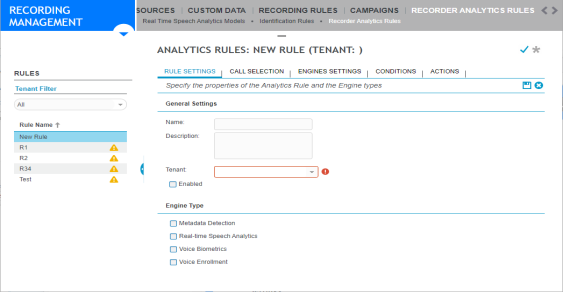Rule settings
Rule Settings includes the name, the description, the engines used by the Recorder Analytics Rule, and defines if the rule is activated.

|
Rule Setting |
Description |
|---|---|
|
Name |
Mandatory. The name for the Recorder Analytics Rule. |
|
Description |
Optional. Meaningful information that describes the Recorder Analytics Rule. For example, its purpose. |
|
Tenant |
Only available to administrators of multi-tenant systems. The tenant to whom to assign the Recorder Analytics Rule. If the service provider is also a tenant, and you are creating the rule for the sole use of the provider select Reserve for Provider. Once you save the Rule Settings, you cannot change the tenant assigned to the rule. The tenant name is displayed in parentheses next to the rule name. To see tenant definitions, go to Organization Management. Under Hierarchies, select Tenant Settings. |
|
Enabled |
Defines if the Recorder Analytics Rule is activated on interactions. By default, not activated. |
|
Engine Type |
The engine or engines that are appropriate for the function you want the Recorder Analytics Rule to perform. Only licensed engines are available.
Licensing notes: The appropriate license must be enabled. To see what is enabled, go to System Management. Under Licensing Management, select System Licensing.
|
Example: Identification Rules and automatic enrollment
Example: Identification Rules and identity verification
Workflows for the Real-Time Analytics (RTA) Framework
Manage existing Recorder Analytics Rules
Workforce Optimization Multi-tenant SaaS Service Provider Reference Guide